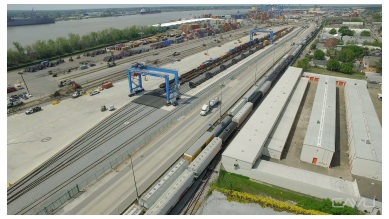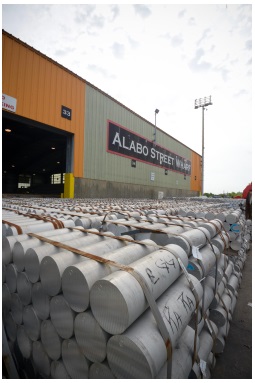Port Traffic Metrics: Baltimore, Germany, New Orleans
![]() Print this Article | Send to Colleague
Print this Article | Send to Colleague
Public marine terminals in the Port of Baltimore handled a record 2.4 million short tons of general cargo during first quarter 2016, reports the Maryland Administration. General cargo includes autos, containers, forest products, roll on/roll off equipment, and breakbulk.
The previous first quarter record, 2.3 million tons, was set in January-March 2012.
In detail, this year’s data show increases from first quarter 2015 of 7 percent in ro/ro in ro/ro traffic (farm and construction equipment) and 1.5 percent in auto traffic, solidifying Baltimore’s position as one of America’s top ro/ro ports. Last year, the MPA signed global shipping and logistics giant Wallenius Wilhelmsen Logistics (WWL) to a new 30-year contract.
It was a record quarter, too, for Baltimore’s container trade, with throughput of 205,164 TEUs (+7.6 percent) and 1.75 million tons of cargo (+5.1 percent). The MPA credits this year’s gain in part to the new Maersk-MSC shipping alliance that began serving Baltimore in 2015.
It has been a good year as well for Baltimore’s cruise trade, with an increase of more than 21,000 passengers compared to first quarter 2015. This was due to the return of the Carnival Pride following extensive renovations that kept the ship out of service for part of 2015. The MPA recently signed a contract extension with its other cruise partner, Royal Caribbean Cruise Lines.
"The Port of Baltimore has had a record-breaking start to 2016 following a very successful 2015," said Governor Larry Hogan. "As one of Maryland’s top economic generators, my administration will continue to work closely with port officials to ensure this growing seaport continues to thrive."
German Seatrade Tonnage, Container Trade Fell in 2015
Germany’s seatrade fell to 296.2 million metric tons, a 2.6 percent drop from 2014 and the lowest total since 2012, according to data reported by the federal statistics agency, Statistisches Bundesamt (Destatis).
Tonnage declines from 2014 of 3.0 percent and 2.7 percent, respectively, were reported for imports and exports, with foreign trade overall dropping to a four year low of 269.3 million tons. Domestic cargo continued its steady upward climb, but at 8.2 million tons, accounted for a minor fraction of total seatrade in 2015.
Container traffic fell by an even steeper 4.6 percent to 15.2 million TEUs, Germany’s smallest annual total since 2008, according to the Destatis data.
Click here for detail.
New Orleans: Port Sets Back-to-Back Record Container Months in March, April; 2015 Container Cargo Surges 7 percent, Total Cargo Up 8.1 Percent

Key factors in New Orleans’ booming container trade - the new Mississippi River Intermodal Terminal, with Napoleon Avenue Container Terminal the background.
Photo/Port of New Orleans
Container throughput hit monthly highs in March and again in April at the Port of New Orleans’ Napoleon Avenue Container Terminal.
In detail, the April count of 50,074 TEUs beat the port’s previously monthly record, March’s 48,954 TEUs. The two month total of 99,588 TEUs was up 6.1 percent compared to March-April 2015.
This year’s container surge follow the port’s strong performance in 2015 when gains in metal imports and chemical exports helped push general cargo to new highs, according to figures released last week by the port.
General cargo worked at the port’s public docks totaled 8.6 million tons, up nearly 3 percent from 8.3 million tons in 2014. Cargo port-wide, including mid-stream as well as dockside operations, rose 8.1 percent, from 31 million to 33.5 million tons. It was a banner year, too, for Napoleon Avenue Container Terminal, where throughput rose 7 percent to a record 525,485 TEUs.
"Continued growth in cargo figures is attributable to our efficient terminal operators, valued customers and the hard work of the entire port community," said Port President Gary LaGrange, PPM®. "All of that hard work is also paying off with international recognition from trusted transportation publications citing the port’s productivity."
Among exports, chemicals increased by 7.1 percent to 1.86 million tons and forest products by 5.4 percent to 435,056 tons. Top performing imports were: non-ferrous metals, including zinc – 499,287 tons (+44.4 percent); natural rubber – 364,265 tons (+3.4 percent); and coffee – 261,802 tons (+3.8 percent). Imported steel fell 7.6 percent to 3.27 million tons.

Offloading aluminum billets at Alabo Street Wharf
Photo/Port of New Orleans
Recent port and terminal operator investments could lead to further growth in the coming year. They include a $7.9 million racking system jointly financed by the port and New Orleans Terminal LLC capable of storing more than 600 refrigerated containers at one time.
Additionally, New Orleans Terminal invested $4.5 million to assemble two new rubber-tire gantry cranes in an effort to speed up container handling and turn times. Ports America invested $2.2 million in new technology at the gate and within the terminal aimed at improving efficiency and turn times for truck drivers.
Still another is the $25 million Mississippi River Intermodal Terminal that began operations in March. The 12-acre intermodal container transfer terminal facilitates the movement of marine and rail cargo, while enhancing safety and reducing the carbon footprint of the regional and national transportation systems.
It was a prosperous year as well for New Orleans’ cruise terminals, with a total of 1,027,700 embarking, debarking and in-transit passengers on deepwater and river cruises. That was up 1 percent compared to 2014, giving the port a fifth consecutive record year and its second year with a million-plus passenger count. With larger and newer ships positioned in New Orleans, the port hopes to attract even more cruise tourists in 2016.
.jpg)
Cruise ships line the New Orleans waterfront in a recent photo
Photo/Port of New Orleans

